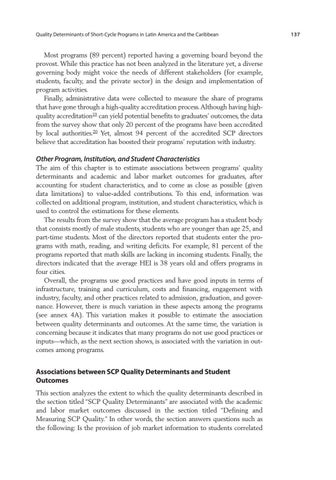Quality Determinants of Short-Cycle Programs in Latin America and the Caribbean
Most programs (89 percent) reported having a governing board beyond the provost. While this practice has not been analyzed in the literature yet, a diverse governing body might voice the needs of different stakeholders (for example, students, faculty, and the private sector) in the design and implementation of program activities. Finally, administrative data were collected to measure the share of programs that have gone through a high-quality accreditation process. Although having highquality accreditation19 can yield potential benefits to graduates’ outcomes, the data from the survey show that only 20 percent of the programs have been accredited by local authorities.20 Yet, almost 94 percent of the accredited SCP directors believe that accreditation has boosted their programs’ reputation with industry.
Other Program, Institution, and Student Characteristics The aim of this chapter is to estimate associations between programs’ quality determinants and academic and labor market outcomes for graduates, after accounting for student characteristics, and to come as close as possible (given data limitations) to value-added contributions. To this end, information was collected on additional program, institution, and student characteristics, which is used to control the estimations for these elements. The results from the survey show that the average program has a student body that consists mostly of male students, students who are younger than age 25, and part-time students. Most of the directors reported that students enter the programs with math, reading, and writing deficits. For example, 81 percent of the programs reported that math skills are lacking in incoming students. Finally, the directors indicated that the average HEI is 38 years old and offers programs in four cities. Overall, the programs use good practices and have good inputs in terms of infrastructure, training and curriculum, costs and financing, engagement with industry, faculty, and other practices related to admission, graduation, and governance. However, there is much variation in these aspects among the programs (see annex 4A). This variation makes it possible to estimate the association between quality determinants and outcomes. At the same time, the variation is concerning because it indicates that many programs do not use good practices or inputs—which, as the next section shows, is associated with the variation in outcomes among programs.
Associations between SCP Quality Determinants and Student Outcomes This section analyzes the extent to which the quality determinants described in the section titled “SCP Quality Determinants” are associated with the academic and labor market outcomes discussed in the section titled “Defining and Measuring SCP Quality.” In other words, the section answers questions such as the following: Is the provision of job market information to students correlated
137

